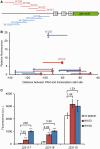Programmable repression and activation of bacterial gene expression using an engineered CRISPR-Cas system
- PMID: 23761437
- PMCID: PMC3753641
- DOI: 10.1093/nar/gkt520
Programmable repression and activation of bacterial gene expression using an engineered CRISPR-Cas system
Abstract
The ability to artificially control transcription is essential both to the study of gene function and to the construction of synthetic gene networks with desired properties. Cas9 is an RNA-guided double-stranded DNA nuclease that participates in the CRISPR-Cas immune defense against prokaryotic viruses. We describe the use of a Cas9 nuclease mutant that retains DNA-binding activity and can be engineered as a programmable transcription repressor by preventing the binding of the RNA polymerase (RNAP) to promoter sequences or as a transcription terminator by blocking the running RNAP. In addition, a fusion between the omega subunit of the RNAP and a Cas9 nuclease mutant directed to bind upstream promoter regions can achieve programmable transcription activation. The simple and efficient modulation of gene expression achieved by this technology is a useful asset for the study of gene networks and for the development of synthetic biology and biotechnological applications.
Figures




References
-
- Auslander S, Fussenegger M. From gene switches to mammalian designer cells: present and future prospects. Trends Biotechnol. 2012;31:155–168. - PubMed
-
- Miller JC, Tan S, Qiao G, Barlow KA, Wang J, Xia DF, Meng X, Paschon DE, Leung E, Hinkley SJ, et al. A TALE nuclease architecture for efficient genome editing. Nat. Biotechnol. 2011;29:143–148. - PubMed
Publication types
MeSH terms
Substances
Grants and funding
LinkOut - more resources
Full Text Sources
Other Literature Sources
Research Materials

